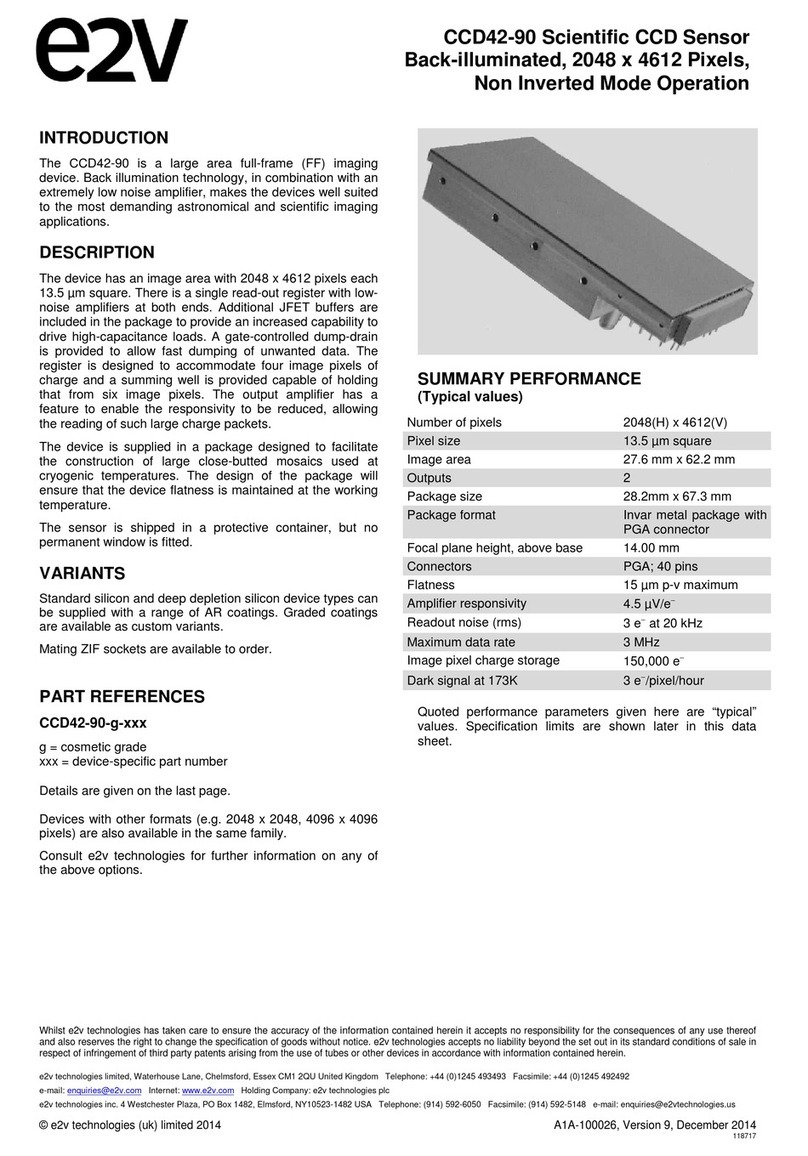
FEATURES
*2048 by 4608 Pixel Format
*13.5 mm Square Pixels
*Image Area 27.6 x 62.2 mm
*Back Illuminated Format for High Quantum Efficiency
*Low Noise Output Amplifiers
*Wide Dynamic Range
*Symmetrical Anti-static Gate Protection
*3-side Buttable Package
*Gated Dump Drain on Readout Register
*Flatness better than 15 mm peak to valley
APPLICATIONS
*Astronomy
*Scientific Imaging
INTRODUCTION
This version of the CCD42 family of CCD sensors has full-frame
architecture. Back illumination technology, in combination with
an extremely low noise amplifier, makes the device well suited
to the most demanding applications, such as astronomy.
The output amplifier is designed to give excellent noise levels at
low pixel rates and can match the noise performance of most
conventional scientific CCDs at pixel rates as high as 1 MHz.
The low output impedance and optional FET buffer simplify the
interface with external electronics.
The readout register has a gate controlled dump-drain to allow
fast dumping of unwanted data. The register is designed to
accommodate four image pixels of charge and a summing well
is provided capable of holding six image pixels. The output
amplifier has a feature to enable the responsivity to be reduced,
allowing the reading of such large charge packets.
The device is supplied in a package designed to facilitate the
construction of large close-butted mosaics and is designed to
be used cryogenically. The design of the package will ensure
that the device flatness is maintained at the working
temperature.
The sensor is shipped in a protective container, but no
permanent window is fitted.
TYPICAL PERFORMANCE (at 173 K)
Pixel readout frequency .....20–3000 kHz
Output amplifier sensitivity .......4.5 mV/e
7
Peak signal ........... 150 ke
7
/pixel
Spectral range ....... 200–1060 nm
Readout noise (at 20 kHz) .......3 e
7
rms
QEat500nm .......... 90 %
Charge transfer efficiency ...... 99.9995 %
GENERAL DATA
Format
Image area ......... 27.6 x 62.2 mm
Active pixels (H) ........ 2048
(V) .......4608 + 4
Pixel size .......... 13.5 x 13.5 mm
Number of output amplifiers ......2
Number of underscan (serial) pixels . . . 50
The device has a 100% fill factor.
Package
Format .... invar metal package with PGA connector
Focal plane height above base ..... 14.0 mm
Package size ......... 28.2 x 67.3 mm
Package weight .......... 150 gapprox
Number of pins .......... 40
Inactive edge spacing:
sides ...........260+50 mm
top ...........120+50 mm
bottom (edge connections) ......5.0 mm
CCD42-90 Back Illuminated
High Performance CCD Sensor
#e2v technologies (uk) limited 2006 A1A-100026 Issue 8, March 2006
411/9572
e2v technologies (uk) limited, Waterhouse Lane, Chelmsford, Essex CM1 2QU, UK Telephone: +44 (0)1245 493493 Facsimile: +44 (0)1245 492492
e-mail: enquiries@e2v.com Internet: www.e2v.com Holding Company: e2v technologies plc
e2v technologies inc. 4 Westchester Plaza, PO Box 1482, Elmsford, NY10523-1482 USA Telephone: (914) 592-6050 Facsimile: (914) 592-5148




























